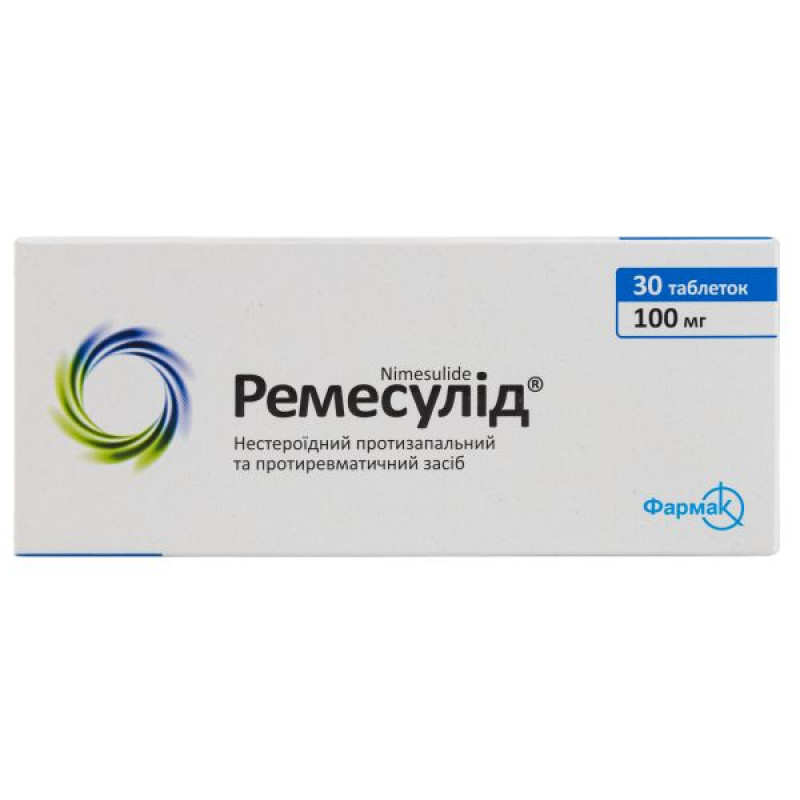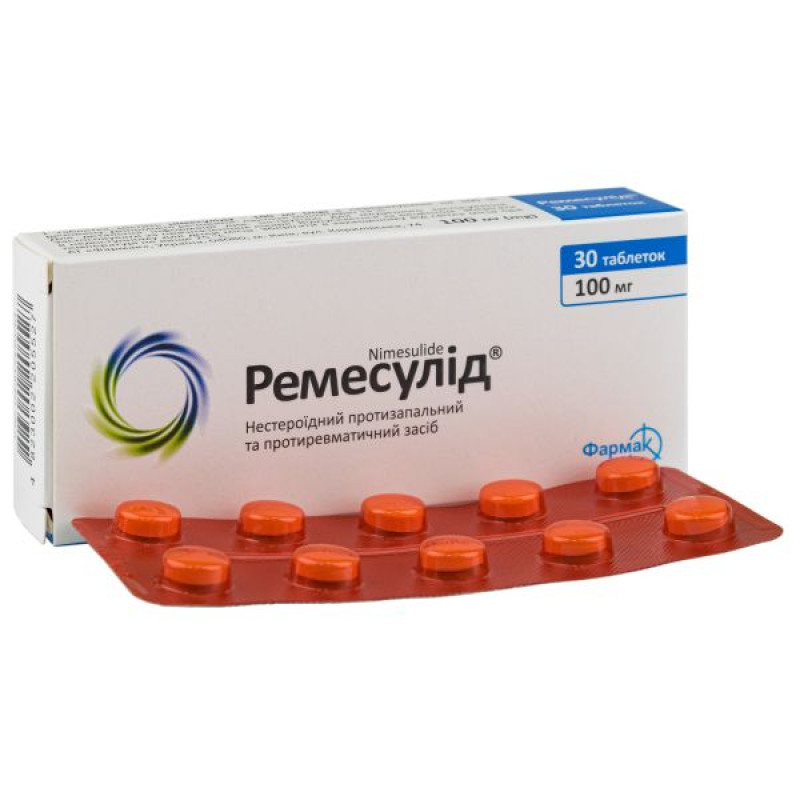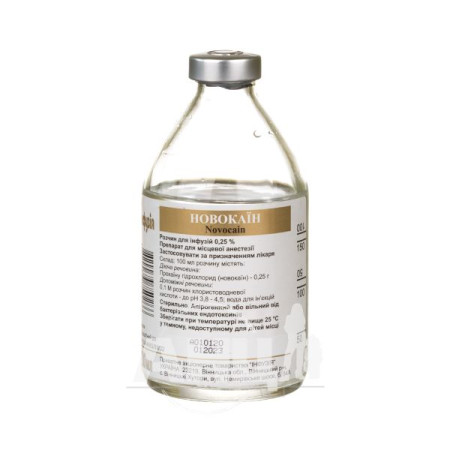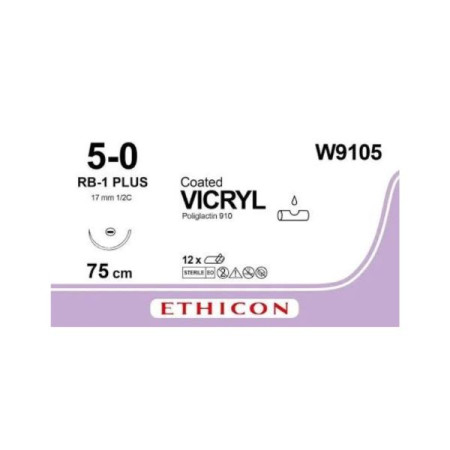Remesulide tablets 100 mg blister No. 30
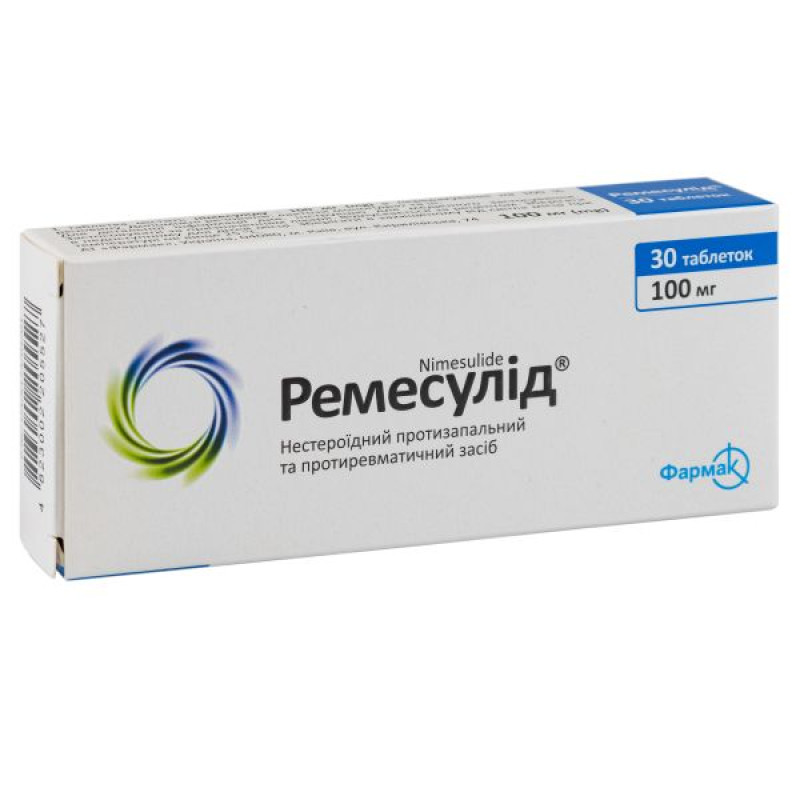
Instructions for Remesulide tablets 100 mg blister No. 30
Composition
active ingredient: nimesulide;
1 tablet contains nimesulide in terms of 100% substance 100 mg;
Excipients: lactose monohydrate, potato starch, hypromellose, colloidal anhydrous silica, crospovidone, magnesium stearate.
Dosage form
Pills.
Main physicochemical properties: tablets of yellowish or yellowish-greenish color with a biconvex surface. Marbling is allowed on the surface of the tablets.
Pharmacotherapeutic group
Nonsteroidal anti-inflammatory and antirheumatic drugs. ATC code M01A X17.
Pharmacological properties
Pharmacodynamics
Nimesulide is an active substance that has anti-inflammatory, analgesic and antipyretic properties. Nimesulide selectively inhibits COX II (cyclooxygenase II) and suppresses the synthesis of prostaglandins in the focus of inflammation.
Nimesulide inhibits the release of the enzyme myeloperoxidase, and also inhibits the formation of free oxygen radicals, without affecting the processes of phagocytosis and chemotaxis, and inhibits the formation of tumor necrosis factor and other inflammatory mediators.
Pharmacokinetics
When administered orally, nimesulide is rapidly absorbed from the gastrointestinal tract. The maximum concentration in the blood plasma is determined after 2-3 hours. The binding of nimesulide to blood plasma proteins reaches 97.5%.
The drug is metabolized in the liver, the main metabolic product is hydroxynimesulide, a pharmacologically active substance.
About 65% of the administered dose of nimesulide is excreted in the urine, the remaining 35% in the feces.
Indication
Treatment of acute pain, primary dysmenorrhea. Remesulide® should only be used as a second-line drug. The decision to prescribe nimesulide should be made based on an assessment of all the risks for the individual patient.
Contraindication
Hypersensitivity to nimesulide or any component of the drug. History of hypersensitivity reactions (bronchospasm, rhinitis, urticaria) to the use of acetylsalicylic acid or other NSAIDs. History of hepatotoxic reactions to nimesulide. Concomitant use of other substances with potential hepatotoxicity. Alcoholism and drug addiction. History of gastrointestinal bleeding or perforation associated with previous use of NSAIDs. Gastric or duodenal ulcer in the acute phase, history of ulcer, perforation or bleeding in the digestive tract. History of cerebrovascular bleeding or other hemorrhages, as well as diseases accompanied by bleeding. Severe blood clotting disorders. Severe heart failure. Severe renal dysfunction. Liver dysfunction. Patients with elevated body temperature and/or flu-like symptoms. Children under 12 years of age. 3rd trimester of pregnancy or breastfeeding.
Interaction with other medicinal products and other types of interactions
Pharmacodynamic interactions.
Corticosteroids: Increased risk of gastrointestinal ulceration or bleeding.
Antiplatelet agents and selective serotonin reuptake inhibitors (SSRIs): increased risk of gastrointestinal bleeding.
Anticoagulants: NSAIDs may enhance the effect of anticoagulants such as warfarin or acetylsalicylic acid, which is why this combination is contraindicated in patients with severe coagulation disorders. If such combination therapy cannot be avoided, careful monitoring of blood coagulation parameters is necessary.
Diuretics, angiotensin-converting enzyme inhibitors and angiotensin II antagonists. NSAIDs may weaken the effect of diuretics and other antihypertensive drugs. In some patients with impaired renal function (e.g. dehydrated patients or elderly patients), the simultaneous use of ACE inhibitors, angiotensin II antagonists or agents that inhibit the cyclooxygenase system may lead to further deterioration of renal function and the development of acute renal failure, which is usually reversible. These interactions should be taken into account when the patient uses nimesulide simultaneously with ACE inhibitors or angiotensin II antagonists. Great caution should be exercised when using this combination, especially in elderly patients. Patients should receive sufficient fluids and renal function should be closely monitored after the start of the combination. Remesulide® temporarily weakens the effect of furosemide on sodium excretion and, to a lesser extent, potassium excretion, and also reduces the diuretic effect. The simultaneous use of furosemide and nimesulide in patients with impaired renal or cardiac function requires caution.
In healthy volunteers, nimesulide rapidly reduces the sodium-excreting and, to a lesser extent, potassium-excreting effects of furosemide, and also reduces the diuretic effect. Simultaneous administration of nimesulide and furosemide leads to a decrease (approximately 20%) in the area under the concentration-time curve (AUC) and a decrease in the cumulative excretion of furosemide without changes in the renal clearance of furosemide.
NSAIDs have been reported to reduce lithium clearance, leading to increased plasma lithium levels and lithium toxicity. When Remesulide is prescribed to patients receiving lithium therapy, frequent monitoring of plasma lithium levels should be performed.
There is no clinically significant interaction with glibenclamide, theophylline, warfarin, digoxin, cimetidine and antacids (aluminum and magnesium hydroxide combination) in vivo. Remesulide® inhibits the activity of the CYP2C9 enzyme. When used simultaneously with Remesulide®, drugs that are substrates of this enzyme may increase their plasma concentrations. Caution is required if nimesulide is administered less than 24 hours before or less than 24 hours after taking methotrexate, since it is possible to increase the level of the latter in the blood serum and increase its toxicity.
Due to their effect on renal prostaglandins, synthetase inhibitors, to which nimesulide belongs, may increase the nephrotoxicity of cyclosporines.
The effect of other drugs on nimesulide.
In vitro studies have shown that nimesulide is displaced from its binding sites by tolbutamide, salicylic acid and valproic acid. Although these interactions have been identified in plasma, these effects have not been observed during clinical use of the drug.
Application features
Undesirable side effects can be minimized by using the lowest effective dose for the shortest period of time necessary to control symptoms.
If the treatment is ineffective (reduction in symptoms of the disease), therapy with the drug should be discontinued.
During treatment with nimesulide, it is recommended to avoid the simultaneous use of hepatotoxic drugs, as well as to refrain from drinking alcohol. The use of nonsteroidal anti-inflammatory drugs may mask an increase in body temperature associated with a background bacterial infection. In the event of an increase in body temperature or the appearance of flu-like symptoms in patients using nimesulide, the drug should be discontinued.
Serious hepatic reactions, including fatalities, have been reported during treatment with nimesulide. Patients who develop symptoms suggestive of liver disease, such as anorexia, nausea, vomiting, abdominal pain, fatigue, dark urine, or patients with abnormal liver function tests should discontinue the drug. Re-administration of nimesulide to such patients is contraindicated. During treatment with nimesulide, the patient should refrain from taking other analgesics. Concomitant use of other NSAIDs, including selective cyclooxygenase-2 inhibitors, should be avoided.
Patients taking nimesulide who develop flu-like symptoms should discontinue its use.
Elderly patients have an increased frequency of adverse reactions to NSAIDs, especially possible bleeding and perforations in the digestive tract, which can be fatal.
Ulceration, bleeding or perforation in the digestive tract can be life-threatening, especially if there is a history of similar events in the patient when using any other NSAIDs (without a prescription). The risk of such events increases with increasing NSAID dose in patients with a history of gastrointestinal ulcer, especially complicated by bleeding or perforation, and in elderly patients. In such patients, treatment should be started with the lowest possible effective dose. For these patients, as well as for those taking concomitant low doses of acetylsalicylic acid or other drugs that increase the risk of gastrointestinal complications, the possibility of using combination therapy with the use of protective agents, such as misoprostol or proton pump inhibitors, should be considered.
Patients with toxic lesions of the digestive tract, especially elderly patients, should report any unusual symptoms that occur in the digestive tract, especially bleeding. This is especially important in the initial stages of treatment. Patients taking concomitant medications that may increase the risk of ulceration or bleeding, such as corticosteroids, anticoagulants, selective serotonin reuptake inhibitors, antiplatelet agents (acetylsalicylic acid), should be informed of the need to exercise caution when using nimesulide.
If a patient receiving Remesulide® experiences bleeding or ulcers in the digestive tract, treatment with the drug should be discontinued.
NSAIDs should be prescribed with caution to patients with Crohn's disease or a history of nonspecific ulcerative colitis, as nimesulide may lead to their exacerbation.
Concomitant use of nimesulide with other drugs, such as oral contraceptives, anticoagulants, antiplatelet agents, may cause exacerbation of Crohn's disease and other diseases of the digestive tract.
Clinical trials and epidemiological data suggest that some NSAIDs, especially at high doses and with long-term use, may carry a small risk of arterial thrombotic events, such as myocardial infarction and stroke. There is insufficient data to exclude a risk of such events with nimesulide.
Patients with uncontrolled hypertension, acute heart failure, established ischemic heart disease, peripheral arterial disease and/or cerebrovascular disease should be prescribed nimesulide after careful assessment of the condition. The same should be done before prescribing the drug to patients with risk factors for cardiovascular disease, such as hypertension, hyperlipidemia, diabetes mellitus, and smoking.
Patients with impaired renal function or heart failure should be prescribed the drug with caution due to the possibility of worsening renal function. In case of deterioration of the patient's condition, treatment should be discontinued.
Elderly patients require careful monitoring due to the possibility of bleeding and perforation of the gastrointestinal tract, deterioration of renal, hepatic or cardiac function. Since nimesulide may affect platelet function, it should be prescribed with caution to patients with hemorrhagic diathesis. However, nimesulide does not replace acetylsalicylic acid in the prevention of cardiovascular diseases.
There have been rare reports of severe skin reactions with NSAIDs, some of which may be fatal, such as exfoliative dermatitis, Stevens-Johnson syndrome, toxic epidermal necrolysis. In most cases, if these reactions occurred during the first month of previously prescribed treatment, the risk of their occurrence in patients is significantly increased. Remesulide® should be discontinued at the first signs of skin rash, mucosal lesions and other allergic manifestations.
The drug contains lactose, therefore patients with rare hereditary forms of galactose intolerance, the Lapp lactase deficiency or glucose-galactose malabsorption syndrome should not use the drug.
Ability to influence reaction speed when driving vehicles or other mechanisms
Studies of the effect of nimesulide on the ability to drive or use machines have not been conducted, but if patients experience headaches, dizziness, or drowsiness while taking nimesulide, they should refrain from driving or operating machinery.
Use during pregnancy or breastfeeding
Inhibition of prostaglandin synthesis may adversely affect pregnancy and/or foetal development. Epidemiological data suggest that use of prostaglandin synthesis inhibitors in early pregnancy may increase the risk of spontaneous abortion, foetal heart defects and gastroschisis. The absolute risk of cardiovascular malformation has been reported to increase from less than 1% to approximately 1.5%. The risk is thought to increase with dose and duration of exposure.
Nimesulide should not be taken during the first and second trimesters of pregnancy unless clearly necessary. If the drug is used in women attempting to conceive or during the first and second trimesters of pregnancy, the lowest possible dose and the shortest possible duration of treatment should be used.
In the third trimester of pregnancy, all prostaglandin synthesis inhibitors can lead to the development of the following in the fetus:
pneumocardiac toxic lesion (with premature closure of the ductus arteriosus and hypertension in the pulmonary artery system); renal dysfunction, which may progress to renal failure with the development of oligohydramnios.
In the mother and fetus at the end of pregnancy, it is possible:
increased bleeding time, anti-aggregation effect, which may occur even when using very low doses of the drug; inhibition of uterine contractile activity, which may lead to a delay or prolongation of the period of labor.
Therefore, nimesulide is contraindicated in the third trimester of pregnancy.
As an NSAID that inhibits prostaglandin synthesis, nimesulide can cause premature closure of the ductus arteriosus, pulmonary hypertension, oliguria, oligohydramnios. The risk of bleeding, labor weakness and peripheral edema increases. There are isolated reports of renal failure in infants whose mothers used nimesulide at the end of pregnancy. The potential risk for humans has not been determined, therefore, the use of nimesulide in the I and II trimesters of pregnancy is not recommended. Since it is not known whether nimesulide penetrates into breast milk, its use is contraindicated during breastfeeding.
Nimesulide may impair female fertility and is therefore not recommended for use in women attempting to conceive. Women who are unable to conceive or who are undergoing investigation of infertility should consider discontinuing nimesulide. If pregnancy occurs during treatment with nimesulide, the physician should be informed.
Method of administration and doses
In order to prevent and reduce the occurrence of adverse reactions, the drug should be taken for the shortest possible time and in the minimum effective dose. The drug should be prescribed only after a careful assessment of the risk/benefit ratio.
The drug should be taken orally after meals and washed down with sufficient fluid.
For adults and children over 12 years of age – 1 tablet (100 mg) 2 times a day – morning and evening. The maximum duration of treatment is 15 days.
For elderly patients, the indicated dosage regimen does not require correction.
No dose adjustment is required for patients with mild or moderate renal impairment (creatinine clearance 30-80 ml/min).
Children
Remesulide® is contraindicated in children under 12 years of age.
Overdose
Symptoms of acute overdose with nonsteroidal anti-inflammatory drugs are usually limited to the following: apathy, drowsiness, nausea, vomiting, epigastric pain. These symptoms are usually reversible with supportive therapy. Gastrointestinal bleeding, arterial hypertension, acute renal failure, respiratory depression, coma are possible, but such phenomena occur rarely. There have been reports of anaphylactoid reactions when using therapeutic doses of NSAIDs and in case of their overdose. There is no specific antidote. Treatment of overdose is symptomatic and supportive. There is no data on the removal of nimesulide by hemodialysis, but if we take into account the high degree of binding of nimesulide to blood plasma proteins (up to 97.5%), then dialysis is unlikely to be effective. In the presence of symptoms of overdose or after the use of a large dose of the drug within 4 hours after its administration, patients may be prescribed: artificial induction of vomiting, and/or administration of activated charcoal (60-100 g for adults) and/or administration of an osmotic laxative. Forced diuresis, increased urine alkalinity, hemodialysis and hemoperfusion may be ineffective due to the high degree of binding of nimesulide to blood plasma proteins. Kidney and liver function should be monitored.
Adverse reactions
From the blood system: anemia, eosinophilia, thrombocytopenia, pancytopenia, purpura.
Immune system disorders: hypersensitivity, anaphylaxis.
Metabolic disorders: hyperkalemia.
On the part of the psyche: feelings of fear, nervousness, terrible dreams.
Nervous system: dizziness, headache, drowsiness, encephalopathy (Reye's syndrome).
From the organs of vision: blurred vision, visual disturbances.
On the part of the organs of hearing: vertigo.
Cardiovascular system: tachycardia, hemorrhage, blood pressure lability, hot flashes, arterial hypertension, increased risk of arterial thrombotic complications, such as myocardial infarction or stroke, heart failure.
From the respiratory system: shortness of breath, asthma, bronchospasm.
From the digestive tract: diarrhea; nausea; vomiting, including bloody vomiting; constipation; flatulence; gastritis; abdominal pain; dyspepsia; stomatitis; black stools; bleeding in the digestive tract; duodenal/gastric ulcer and perforation; exacerbation of colitis and Crohn's disease.
Hepatobiliary system: hepatitis; fulminant hepatitis, with fatal outcome, including jaundice; cholestasis.
Skin: itching, skin rash, increased sweating, erythema, dermatitis, urticaria, angioedema, facial edema, erythema multiforme, Stevens-Johnson syndrome, toxic epidermal necrolysis.
From the urinary system: dysuria, hematuria, urinary retention, renal failure, oliguria, interstitial nephritis.
General disorders: edema, malaise, asthenia, hypothermia.
Laboratory indicators: increased liver enzymes.
Expiration date
5 years.
Do not use the drug after the expiration date indicated on the package.
Storage conditions
Store in a place protected from light at a temperature not exceeding 25 °C.
Keep out of reach of children.
Packaging
10 tablets in a blister. 3 blisters in a pack.
Vacation category
According to the recipe.
Producer
JSC "Farmak".
Location of the manufacturer and its business address
Ukraine, 04080, Kyiv, Kyrylivska St., 74.
There are no reviews for this product.
There are no reviews for this product, be the first to leave your review.
No questions about this product, be the first and ask your question.







